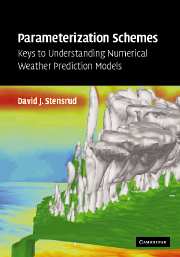Book contents
- Frontmatter
- Contents
- Preface
- List of principal symbols and abbreviations
- 1 Why study parameterization schemes?
- 2 Land surface–atmosphere parameterizations
- 3 Soil–vegetation–atmosphere parameterizations
- 4 Water–atmosphere parameterizations
- 5 Planetary boundary layer and turbulence parameterizations
- 6 Convective parameterizations
- 7 Microphysics parameterizations
- 8 Radiation parameterizations
- 9 Cloud cover and cloudy-sky radiation parameterizations
- 10 Orographic drag parameterizations
- 11 Thoughts on the future
- References
- Index
5 - Planetary boundary layer and turbulence parameterizations
Published online by Cambridge University Press: 05 September 2013
- Frontmatter
- Contents
- Preface
- List of principal symbols and abbreviations
- 1 Why study parameterization schemes?
- 2 Land surface–atmosphere parameterizations
- 3 Soil–vegetation–atmosphere parameterizations
- 4 Water–atmosphere parameterizations
- 5 Planetary boundary layer and turbulence parameterizations
- 6 Convective parameterizations
- 7 Microphysics parameterizations
- 8 Radiation parameterizations
- 9 Cloud cover and cloudy-sky radiation parameterizations
- 10 Orographic drag parameterizations
- 11 Thoughts on the future
- References
- Index
Summary
Introduction
We have seen how the various properties of the land surface can influence the fluxes of energy that occur in the atmospheric surface layer. Now that these boundary conditions have been described, the next step is to determine how these energy fluxes influence the evolution of the atmosphere. This influence first occurs within the planetary boundary layer (PBL).
The planetary boundary layer is that part of the troposphere which is influenced directly by the presence of the Earth's surface, and responds to surface forcing with a timescale of an hour or less (Stull 1988). Thus, the land surface and the boundary layer are intimately tied together. The PBL can be as shallow as a few tens of meters, and as deep as several kilometers (Fig. 5.1). We previously learned in Chapters 2 and 3 that the values of temperature and specific humidity within the surface layer have a profound effect on the surface sensible and latent heat fluxes, since they are used in determining the potential difference between the soil–vegetation–land surface and the atmosphere. Now it is seen that the boundary layer responds to these fluxes over very short time periods. It also is important to recognize that turbulence, the irregular fluctuations that occur in fluid motions, is the dominant mechanism by which surface forcing is transmitted throughout the boundary layer.
- Type
- Chapter
- Information
- Parameterization SchemesKeys to Understanding Numerical Weather Prediction Models, pp. 138 - 184Publisher: Cambridge University PressPrint publication year: 2007



